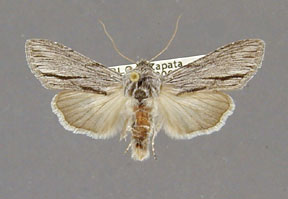
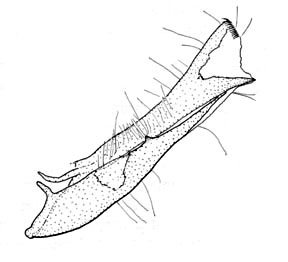
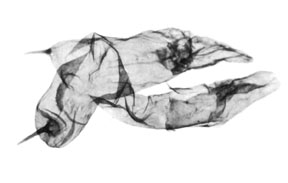
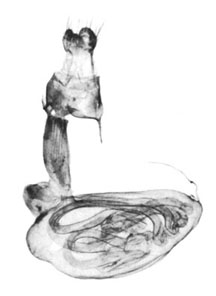
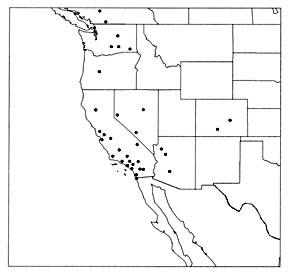
|
Cucullia eulepis (Grote)
Cleophana eulepis Grote, 1875, Bull. Buffalo Soc.
Nat. Hist., 3:86.
Cucullia bistriga Smith, 1892, Proc. U. S. Natl.
Mus., 15:47.
Copicucullia mala Smith, 1908, Ann. New York Acad.
Sci., 18:118.
Diagnosis: Cucullia eulepis is midway in size
and appearance between astigma and cucullioides. Forewing
length from base to apex is approximately 16.5 mm compared with an average
length of 19.5 mm in astigma and 13.5 mm in cuculloides.
The forewing is smooth, light gray to gray without the striate effect
found in cucullioides. The middle of the forewing is usually
noticeably darker than the rest of the wing in eulepis, but the
forewing is uniformly gray in astigma. The foretibia of eulepis
bears a visible claw; the claw is absent in cucullioides. The
first sternite of the male abdomen lacks hair pencils, but hair pencils
are present in cucullioides.
The male genitalia are more similar to those of cucullioides
than to astigma. In particular the clasper is greatly reduced
and the apex of the valve is produced into a ventral projection. The female
ovipositer lobes are narrow and divided into a lower portion with a few
spines and an upper portion bearing several strong spines. This condition
is apparently intermediate between the "normal" ovipositer lobes
of the genus and the extreme modification found in cucullioides.
Cucullia eulepis and cucullioides might not belong to
this group. Although both species have a two-spined vesica, a strong dentate
band exists at the base of the most basal spine-bearing diverticulum,
an atypical condition for most of the species in the group. Secondly,
an obvious digitus exists in both species. A digitus is absent in the
majority of species in Cucullia but is found in these two species
and some species from the Palaeartic, e.g. Cucullia tanaceti
[Denis and Schiffermüller]. Third, the membrane between the seventh
and eighth sternites of the female abdomen is not leathery and tough as
in most other North American species of the genus. The seventh sternite
is unmodified and lacks a distal ledge of specialized patches of scales
in the lateral membranes. The eighth sternite is strongly sclerotized
in both species. Two characters support the inclusion of eulepis
and cucullioides in the antipoda group. The corpus bursae
in both species is strongly perpendicular to the ductus bursae, even more
so than in antipoda, and the apophyses anteriores are very short,
a character shared with antipoda and its relatives. For the moment
eulepis and cucullioides appear best placed in this
group. Wing length from base to apex: mean = 16.49 mm., standard deviation
= 0.80 mm., n = 10.
Distribution: The distribution of this species is spotty.
The species occurs on the eastern, dry edge of the Cascades in Washington
and Oregon. In California it has been collected throughout the state but
perhaps more commonly in southern California, although this may be an
artifact of collecting intensity. Its eastern limit is on the eastern
slope of the Rockies in Colorado. The species is also known from most
of Nevada, and Mohave and Maricopa Counties in Arizona.
Little geographical variability is apparent in this species. A small amount
of within population variability is present in the distinctness of the
markings and the degree of contrast between the costa and middle of the
forewing. None of this variability is particularly significant. Females,
on the whole, are slightly darker than males, particularly the hindwing.
Adults have been collected from March to October. There may be two abundance
peaks in southern California; one in late spring, and another in autumn.
Identification Quality: Excellent
Larva: Unknown
Foodplants: A specimen in the LACM from Los Angeles
County, California was reared from Stephanomeria exigua, an annual
composite.
|


